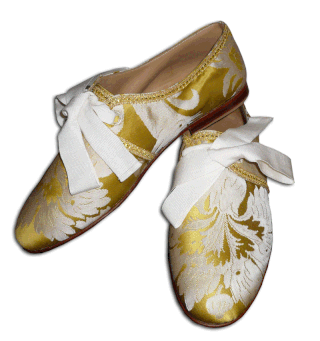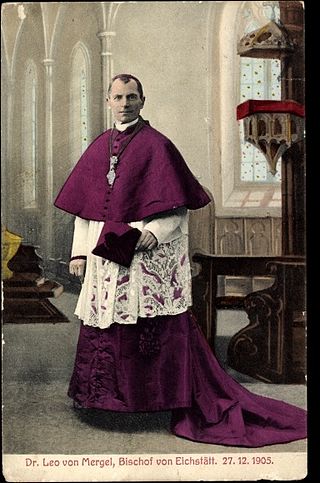An abbreviator or breviator was a writer of the Papal Chancery who adumbrated and prepared in correct form Papal bulls, briefs, and consistorial decrees before these were written out in extenso by the scriptores.

A prelate is a high-ranking member of the Christian clergy who is an ordinary or who ranks in precedence with ordinaries. The word derives from the Latin praelatus, the past participle of praeferre, which means 'carry before', 'be set above or over' or 'prefer'; hence, a prelate is one set over others.

The cassock or soutane is a Christian clerical clothing coat used by the clergy and male religious of the Oriental Orthodox Churches, Eastern Orthodox Church and the Catholic Church, in addition to some clergy in certain Protestant denominations such as Anglicans and Lutherans. "Ankle-length garment" is the literal meaning of the corresponding Latin term, vestis talaris. It is related to the habits traditionally worn by nuns, monks, and friars.

Monsignor is a form of address or title for certain members of the clergy in the Catholic Church. Monsignor is the apocopic form of the Italian monsignore, meaning "my lord". "Monsignor" can be abbreviated as Mons. or Msgr. In some countries, the title "monsignor" is used as a form of address for bishops. However, in English-speaking countries, the title is unrelated to the episcopacy, though many priests with the title later become bishops.
A Prelate of Honour of His Holiness is a Catholic prelate to whom the Pope has granted this title of honour.
The word prothonotary is recorded in English since 1447, as "principal clerk of a court," from L.L. prothonotarius, from Greek protonotarios "first scribe," originally the chief of the college of recorders of the court of the Byzantine Empire, from Greek πρῶτοςprotos "first" + Latin notarius ("notary"); the -h- appeared in Medieval Latin. The title was awarded to certain high-ranking notaries.

Episcopal sandals, also known as pontifical sandals, are a Catholic pontifical vestment worn by bishops when celebrating liturgical functions according to the pre–Vatican II rubrics, for example a Tridentine Solemn Pontifical Mass.
The hierarchy of the Catholic Church consists of its bishops, priests, and deacons. In the ecclesiological sense of the term, "hierarchy" strictly means the "holy ordering" of the church, the Body of Christ, so to respect the diversity of gifts and ministries necessary for genuine unity.

A pectoral cross or pectorale is a cross that is worn on the chest, usually suspended from the neck by a cord or chain. In ancient and medieval times pectoral crosses were worn by both clergy and laity, but by the end of the Middle Ages the pectoral cross came to be a special indicator of position worn by bishops. In the Roman Catholic Church, the wearing of a pectoral cross remains restricted to popes, cardinals, bishops and abbots. In Eastern Orthodox Church and Byzantine Catholic Churches that follow a Slavic Tradition, priests also wear pectoral crosses, while deacons and minor orders do not. The modern pectoral cross is relatively large, and is different from the small crosses worn on necklaces by many Christians. Most pectoral crosses are made of precious metals and some contain precious or semi-precious gems. Some contain a corpus like a crucifix while others use stylized designs and religious symbols.

Choir dress is the traditional vesture of the clerics, seminarians and religious of Christian churches worn for public prayer and the administration of the sacraments except when celebrating or concelebrating the Eucharist. It differs from the vestments worn by the celebrants of the Eucharist, being normally made of fabrics such as wool, cotton or silk, as opposed to the fine brocades used in vestments. It may also be worn by lay assistants such as acolytes and choirs. It was abandoned by most of the Protestant churches that developed from the sixteenth-century Reformation.

The mozzetta is a short elbow-length sartorial vestment, a cape that covers the shoulders and is buttoned over the frontal breast area. It is worn over the rochet or cotta as part of choir dress by some of the clergy of the Catholic Church, among them the pope, cardinals, bishops, abbots, canons and religious superiors. There used to be a small hood on the back of the mozzetta of bishops and cardinals, but this was discontinued by Pope Paul VI. The hood, however, was retained in the mozzette of certain canons and abbots, and in that of the popes, often trimmed in satin, silk or ermine material.
The papal household or pontifical household, called until 1968 the Papal Court, consists of dignitaries who assist the pope in carrying out particular ceremonies of either a religious or a civil character.
The Prefecture of the Papal Household is the office in charge of the Papal Household, a section of the Roman Curia that comprises the Papal Chapel and the Papal Family.
A mantelletta, Italian diminutive of Latin mantellum 'mantle', is a sleeveless, knee-length, vest-like garment, open in front, with slits instead of sleeves on the sides, fastened at the neck. It was for a period of time even more common than the mozzetta.

The fascia is a sash worn by clerics and seminarians with the cassock in the Roman Catholic Church and in the Anglican Church. It is not worn as a belt but is placed above the waist between the navel and the breastbone (sternum). The ends that hang down are worn on the left side of the body and placed a little forward but not completely off the left hip.

Niccolò Marini was an Italian Cardinal of the Catholic Church who served as secretary of the Congregation for the Oriental Churches from 1917 to 1922, and was elevated to the cardinalate in 1916.
A notarius is a public secretary who is appointed by competent authority to draw up official or authentic documents. In the Roman Catholic Church there have been apostolic notaries and even episcopal notaries. Documents drawn up by notarii are issued chiefly from the official administrative offices, the chanceries; secondly, from tribunals; lastly, others are drawn up at the request of individuals to authenticate their contracts or other acts.

Chaplain of His Holiness is a title of distinction given by the Pope in recognition of a priest’s service to the Church. They are addressed with the honorific of "Monsignor" and have certain privileges with respect to ecclesiastical dress and vestments. In 2013 Pope Francis amended common practice to require that all such priests be at least 65 years of age.

Pontificalis Domus was a motu proprio document issued by Pope Paul VI on 28 March 1968, in the fifth year of his pontificate. It reorganized the Papal Household, which had been known until then as the Papal Court.
In the canon law of the Catholic Church, a notary is a person appointed by competent authority to draw up official or authentic documents. These documents are issued chiefly from the official administrative bureaux, the chanceries; secondly, from tribunals; lastly, others are drawn up at the request of individuals to authenticate their contracts or other acts. The public officials appointed to draw up these three classes of papers have been usually called notaries.













